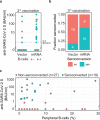Heterologous vector versus homologous mRNA COVID-19 booster vaccination in non-seroconverted immunosuppressed patients: a randomized controlled trial
- PMID: 36097029
- PMCID: PMC9467419
- DOI: 10.1038/s41467-022-33036-y
Heterologous vector versus homologous mRNA COVID-19 booster vaccination in non-seroconverted immunosuppressed patients: a randomized controlled trial
Abstract
Impaired response to COVID-19 vaccination is of particular concern in immunosuppressed patients. To determine the best vaccination strategy for this vulnerable group we performed a single center, 1:1 randomized blinded clinical trial. Patients who failed to seroconvert upon two mRNA vaccinations (BNT162b2 or mRNA-1273) are randomized to receive either a third dose of the same mRNA or the vector vaccine ChAdOx1 nCoV-19. Primary endpoint is the difference in SARS-CoV-2 spike antibody seroconversion rate between vector and mRNA vaccinated patients four weeks after the third dose. Secondary outcomes include cellular immune responses. Seroconversion rates at week four are significantly higher in the mRNA (homologous vaccination, 15/24, 63%) as compared to the vector vaccine group (heterologous vaccination, 4/22, 18%). SARS-CoV-2-specific T-cell responses are reduced but could be increased after a third dose of either vector or mRNA vaccine. In a multivariable logistic regression analysis, patient age and vaccine type are associated with seroconversion. No serious adverse event is attributed to COVID-19 booster vaccination. Efficacy and safety data underline the importance of a booster vaccination and support the use of a homologous mRNA booster vaccination in immunosuppressed patients.Trial registration: EudraCT No.: 2021-002693-10.
© 2022. The Author(s).
Conflict of interest statement
P.M. reports speaker fees from AbbVie, Janssen, and Novartis and research grants from AbbVie, BMS, Novartis, Janssen, MSD, and UCB. M.B. reports about personal fees from Eli Lilly, D.A. received grants and consulting fees from AbbVie, Amgen, Lilly, Merck, Novartis, Pfizer, Roche, and Sandoz, J.S. reports about grants, consulting, and personal fees from AbbVie, Astra-Zeneca, Lilly, Novartis, Amgen, Astro, Bristol-Myers Squibb, Celgene, Celltrion, Chugai, Gilead, ILTOO, Janssen, Merck Sharp & Dohme, Novartis-Sandoz, Pfizer, Roche, Samsung, and UCB, M.Z. received grants and consulting fees from Nabriva, AntibioTxApS, Shionogi, NovoNordisk, Merck, Infectopharm, and Pfizer, H.H. received grants from Glock Health, BlueSky Immunotherapies, and Neutrolis. G.N. served as a speaker/consultant/advisory board member for AbbVie, MSD, Takeda, Janssen, Sandoz, Pfizer, Astro Pharma, Falk Pharma GmbH, Ferring, Gilead, Galapagos, and Vifor. E.S. reports support for meeting attendances from Pfizer and Bristol Myers Squibb. D.M. received support for meeting attendances from Pfizer. T.R. received grant support from Abbvie, Boehringer-Ingelheim, Gilead, Gore, Intercept, MSD, Myr Pharmaceuticals, Philips Healthcare, Pliant, and Siemens; speaking honoraria from Abbvie, Gilead, Gore, Intercept, Roche, MSD; consulting/advisory board fee from Abbvie, Bayer, Boehringer-Ingelheim, Gilead, Intercept, MSD, Siemens; and travel support from Abbvie, Boehringer-Ingelheim, Gilead, and Roche. A.K. reports about speaker and consulting fees from AbbVie, Amgen, Bristol Myers Squibb, Eli Lilly, Gilead, Janssen, Merck Sharp and Dohme, Novartis, and Pfizer. The remaining authors declare no competing interests.
Figures





Similar articles
-
Additional heterologous versus homologous booster vaccination in immunosuppressed patients without SARS-CoV-2 antibody seroconversion after primary mRNA vaccination: a randomised controlled trial.Ann Rheum Dis. 2022 May;81(5):687-694. doi: 10.1136/annrheumdis-2021-221558. Epub 2022 Jan 13. Ann Rheum Dis. 2022. PMID: 35027397 Clinical Trial.
-
Evaluation of the safety and immunogenicity of different COVID-19 vaccine combinations in healthy individuals: study protocol for a randomized, subject-blinded, controlled phase 3 trial [PRIBIVAC].Trials. 2022 Jun 16;23(1):498. doi: 10.1186/s13063-022-06345-2. Trials. 2022. PMID: 35710572 Free PMC article.
-
Safety of heterologous primary and booster schedules with ChAdOx1-S and BNT162b2 or mRNA-1273 vaccines: nationwide cohort study.BMJ. 2022 Jul 13;378:e070483. doi: 10.1136/bmj-2022-070483. BMJ. 2022. PMID: 35831006 Free PMC article.
-
MOG encephalomyelitis after vaccination against severe acute respiratory syndrome coronavirus type 2 (SARS-CoV-2): case report and comprehensive review of the literature.J Neurol. 2022 Oct;269(10):5198-5212. doi: 10.1007/s00415-022-11194-9. Epub 2022 Jun 23. J Neurol. 2022. PMID: 35737110 Free PMC article. Review.
-
Insights From Early Clinical Trials Assessing Response to mRNA SARS-CoV-2 Vaccination in Immunocompromised Patients.Front Immunol. 2022 Mar 4;13:827242. doi: 10.3389/fimmu.2022.827242. eCollection 2022. Front Immunol. 2022. PMID: 35309332 Free PMC article. Review.
Cited by
-
Progress and prospects of mRNA-based drugs in pre-clinical and clinical applications.Signal Transduct Target Ther. 2024 Nov 14;9(1):322. doi: 10.1038/s41392-024-02002-z. Signal Transduct Target Ther. 2024. PMID: 39543114 Free PMC article. Review.
-
Therapeutic induction of antigen-specific immune tolerance.Nat Rev Immunol. 2024 May;24(5):338-357. doi: 10.1038/s41577-023-00970-x. Epub 2023 Dec 12. Nat Rev Immunol. 2024. PMID: 38086932 Free PMC article. Review.
-
Contact pattern, current immune barrier, and pathogen virulence determines the optimal strategy of further vaccination.Infect Dis Model. 2023 Mar;8(1):192-202. doi: 10.1016/j.idm.2023.01.003. Epub 2023 Jan 13. Infect Dis Model. 2023. PMID: 36688089 Free PMC article.
-
Accelerated waning of immune responses to a third COVID-19 vaccination in patients with immune-mediated inflammatory diseases.J Autoimmun. 2023 Feb;135:102981. doi: 10.1016/j.jaut.2022.102981. Epub 2022 Dec 22. J Autoimmun. 2023. PMID: 36706534 Free PMC article.
-
A Comparison of the Immunogenicity and Safety of an Additional Heterologous versus Homologous COVID-19 Vaccination among Non-Seroconverted Immunocompromised Patients after a Two-Dose Primary Series of mRNA Vaccination: A Systematic Review and Meta-Analysis.Vaccines (Basel). 2024 Apr 28;12(5):468. doi: 10.3390/vaccines12050468. Vaccines (Basel). 2024. PMID: 38793719 Free PMC article. Review.
References
Publication types
MeSH terms
Substances
Associated data
LinkOut - more resources
Full Text Sources
Medical
Miscellaneous

